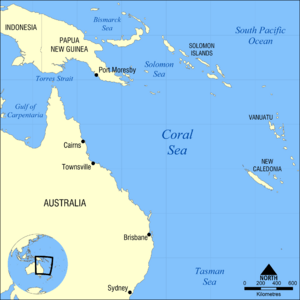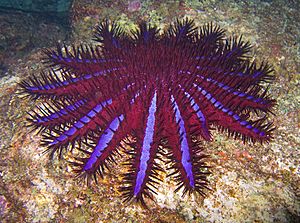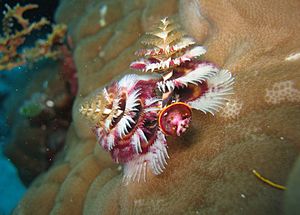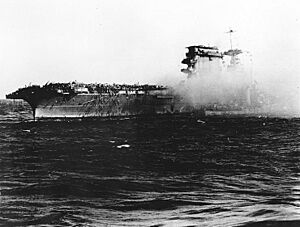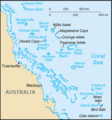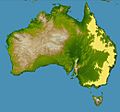Coral Sea facts for kids
The Coral Sea is a part of the South Pacific. It is located off the northeast coast of Australia. This sea gets its name from the many coral reefs found there.
The Coral Sea borders the east coast of Queensland, Australia. This is where you'll find the amazing Great Barrier Reef. To the east, it touches Vanuatu and New Caledonia. In the northeast, it reaches the southern Solomon Islands. To the northwest, it goes up to the south coast of New Guinea, including the Gulf of Papua. The Coral Sea connects with the Tasman Sea in the south and the Solomon Sea in the north. It also links to the Arafura Sea through the Torres Strait.
The Coral Sea has a warm and steady climate. It often rains and experiences tropical cyclones. It is home to many islands and reefs. The most famous is the Great Barrier Reef (GBR). It is the world's largest reef system. UNESCO declared it a World Heritage Site in 1981. To protect the reef, oil exploration stopped in 1975. Fishing is also limited in many areas.
The reefs and islands of the Coral Sea are full of birds and sea creatures. It's a very popular place for tourists. The WWF calls the Coral Sea one of the last true tropical wilderness areas on Earth. Its beautiful coral reefs host many animals. These include different kinds of sharks, manta rays, tuna, barracuda, turtles, whales, and the rare nautilus.
Contents
How the Coral Sea Formed
The Coral Sea basin was created between 58 and 48 million years ago. At that time, the Queensland coast of Australia lifted up. This formed the Great Dividing Range. At the same time, large land blocks sank down. The sea has been a key source of coral for the Great Barrier Reef. This happened both when the reef first formed and when sea levels dropped. The land is still changing, which can be seen from small earthquakes.
The sea is named for its many coral formations. This includes the Great Barrier Reef. The GBR stretches about 2,000 kilometers (1,240 miles) along Australia's northeast coast. It has about 2,900 separate reefs and 1,000 islands. The Chesterfield Islands and Lihou Reef are the biggest atolls in the Coral Sea.
Plants of the Coral Sea
The Australian coast along the Coral Sea is mostly sandy. The Great Barrier Reef is too far away to bring much coral to the shore. However, it acts like a shield, protecting the coast from big ocean waves. Because of this, many land plants grow right down to the sea. The coastal waters are also rich in underwater plants, like green algae.
The islands of the Great Barrier Reef have over 2,000 types of plants. The northern islands have 300 to 350 kinds of woody plants. The southern islands have about 200 kinds of softer, leafy plants. The Whitsunday region is the most diverse, with 1,141 plant species. Birds help spread these plants from island to island.
Animals of the Coral Sea
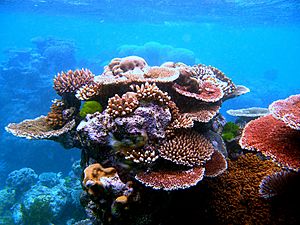
The Coral Sea is home to many different animals. You can find anemones, sponges, and various worms. There are also snails, lobsters, crayfish, prawns, and crabs. Red algae like Lithothamnion and Porolithon make many coral reefs purple-red. The green alga Halimeda is found all over the sea.
The reefs have 400 types of coral, both hard and soft. Most of these corals release their reproductive cells at the same time. This "mass spawning" happens when sea temperatures rise in spring and summer. It is also triggered by the moon and daily cycles. Inner reefs spawn in October, while outer reefs spawn in November and December. There are over 1,500 fish species in the reef systems. Five hundred types of marine algae, or seaweed, live on the reef.
The Crown-of-thorns starfish (Acanthaster planci) is a main predator of the reefs. It eats coral polyps. It climbs onto the coral, pushes its stomach out, and releases chemicals to digest the coral. One adult starfish can eat up to 6 square meters (65 sq ft) of reef in a year. In 2000, a large number of these starfish caused a 66% loss of live coral on some reefs. Changes in water quality and too much fishing of the starfish's natural enemies, like the Giant Triton snail, might have led to more starfish.
There are at least 30 types of whales, dolphins, and porpoises in the sea. These include the dwarf minke whale, Indo-Pacific humpback dolphin, humpback whale, and dugongs. Six types of sea turtles lay their eggs on the Great Barrier Reef. These are the green sea turtle, leatherback sea turtle, hawksbill turtle, loggerhead sea turtle, flatback turtle, and Olive Ridley turtle.
More than 200 bird species visit, nest, or rest on the islands and reefs. This includes the white-bellied sea eagle and roseate tern. Most nesting spots are on islands in the northern and southern parts of the GBR. About 1.4 to 1.7 million birds use these spots to breed.
Seventeen types of sea snakes live on the GBR. They prefer warm waters up to 50 meters (164 ft) deep. They are more common in the southern part of the reef. None of them are unique to the area or endangered. The venom of many of these snakes is very strong. For example, Aipysurus duboisii is thought to be the world's most venomous sea snake.
Around 125 types of sharks, stingrays, skates, and chimaeras live on the GBR. There are also about 5,000 types of molluscs. These include the giant clam and various nudibranchs and cone snails. Saltwater crocodiles live in mangroves and salt marshes along the coast.
Human Activities in the Coral Sea
People have lived in the coastal areas of the Coral Sea for at least 40,000 years. These were prehistoric people who came from the northern islands. Today, about 70 Aboriginal groups live near the Great Barrier Reef.
Shipping has long been important in the Coral Sea. There are 10 major ports just on the Queensland coast. In 2007, over 3,500 ships made more than 9,700 trips in this area. They carried goods like coal, sugar, iron ore, timber, oil, chemicals, and cattle.
Other activities in the sea include fishing and looking for oil in the Gulf of Papua. The sea is also a very popular place for tourists. In 2006–2007, tourism on the Great Barrier Reef brought A$5.1 billion to Australia's economy. Most tourists come from other countries or far parts of Australia. Local people contribute about A$153 million.
For example, about 14.6 million visits were made to the Coral Sea reefs by Queensland residents in 2008. People became worried about how tourism was affecting the environment. Because of this, the Great Barrier Reef Marine Park was created in 1975. There are also smaller state and national parks. In 1981, the Great Barrier Reef was named a World Heritage Site by UNESCO. Since mid-2004, about one-third of the GBR Marine Park is protected. This means no animals or plants can be removed without special permission.
World War II Battle
During World War II, a very important battle happened in the Coral Sea. It was called the Battle of the Coral Sea. This was the first aircraft carrier battle where ships did not see each other. The fighting happened from May 4 to May 8, 1942. All the attacks were carried out by aircraft launched from carriers. No ship fired its guns directly at another.
This was the biggest naval battle fought near Australia. It was very important because it was the first major defeat for Japan. It also stopped Japan from invading Port Moresby, which is the capital city of New Guinea. Many people believe this battle helped save Australia from invasion.
Images for kids
-
The Great Dividing Range has many mountains, plateaus, and hills.
See also
 In Spanish: Mar del Coral para niños
In Spanish: Mar del Coral para niños


